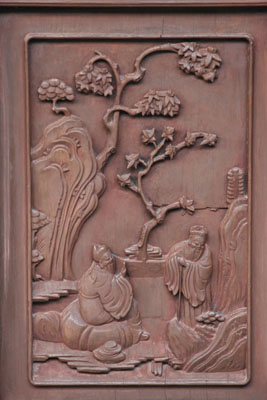Decorative Designs in Chinese Art 中国文物的纹饰
Wood 木料 Architecture 建筑
Click on any word to see more details.
Architecture 建筑
Garden architecture 园林建筑 refers to the various architectural structures used in parks and gardens, such as pavilions 亭 (covered structures without walls), xie (pavilions on terraces) 榭, corridors 廊, ge (two story pavilions) 阁, xuan (pavilions with a view) 轩, storied buildings 楼, terraces 台, and fang (buildings on water) 舫. Chinese garden architecture was highly developed in classical times and, as you can see from this list, there are no good English terms to translate to for the many different kinds of pavilions.
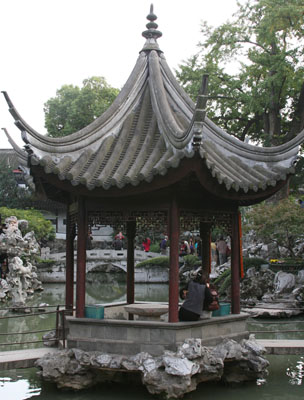
The Humble Administrator's Gardens 拙政园 are one of the finest gardens in China and one of the best places to see traditional Chinese architecture, especially wooden structures. In 1997, along with other classical Chinese gardens in Suzhou, Humble Administrator's Garden, was listed as a UNESCO World Heritage Site. The Humble Administrator's Gardens are the largest of the classical gardens in Suzhou. The site of the gardens was originally the residence of Tang scholar Lu Guimeng. In 1513 Ming Imperial Envoy and poet Wang Xiancheng appropriated the property and began work on the gardens. Cao Xueqin 曹雪芹, author of A Dream of Red Mansions 红楼梦 (c. 1791), lived at the gardens in his teen years and is believed to be an influence on the novel. The most enchanting thing about the gardens is the aesthetic ideal of harmony between nature and people.
The roofs are the most important feature of most structures in Chinese architecture. They often come with some interesting decorations under the eaves, as shown below.
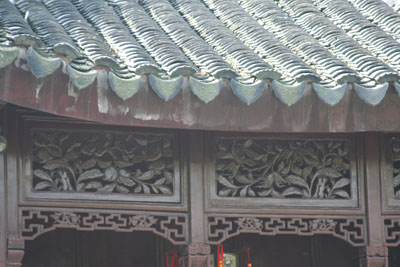
The gardens today mostly resemble their appearance in the late Qing. The numerous pavilions and halls are most interesting for their wooden architecture. There are many decorative elements in the architectural structure and they are fantastic amongst the background of the gardens. I particularly like the windows, which look out into the brilliant sunlight in the gardens. Traditional Chinese architecture often uses an open screen window 漏窗 with the screen made using a decorative design. Open screen windows are a common feature in classical Chinese garden architecture. They separate distinct areas with making them feel inaccessible. An example of this from the Humble Administrator's Garden is shown below.
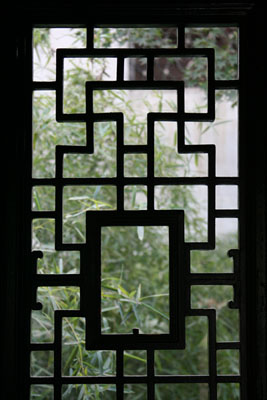
The different designs of the windows of the screens themselves add a lot of interest to the gardens and the building structures. There are many different kinds of designs for the open screen window, the most popular being geometric patterns, flower and plant designs, landscape pictures, and animals. One of the most popular designs, especially in the Suzhou area, is the cracked ice pattern 冰裂 shown below.
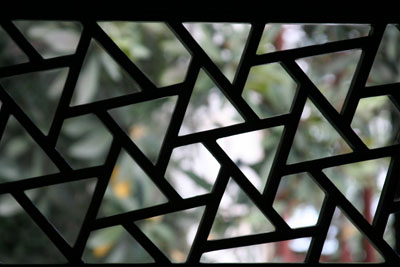
One of the characteristics of the Humble Administrator's Garden is the large amount of water area, whichs gives the garden a natural and peaceful quality. The pavilions and other structures are arranged around these ponds and streams. The open windows, corridors, flower beds, stone gardens, old trees, green bamboo create tranquility and seclusion, while still being connected and interesting. This arrangement is characteristic of Ming garden style.
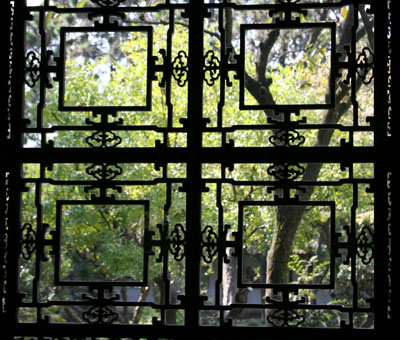
Relief carvings on wood panels like the one below are common on door and wall panels in historic Chinese buildings. In fact, the name for door panel 花板 literally means decorated panel, reflecting the fact that they are nearly always decorated. In homes of important officials no two door or wall panels would be identical.
Chinese
Pinyin English
